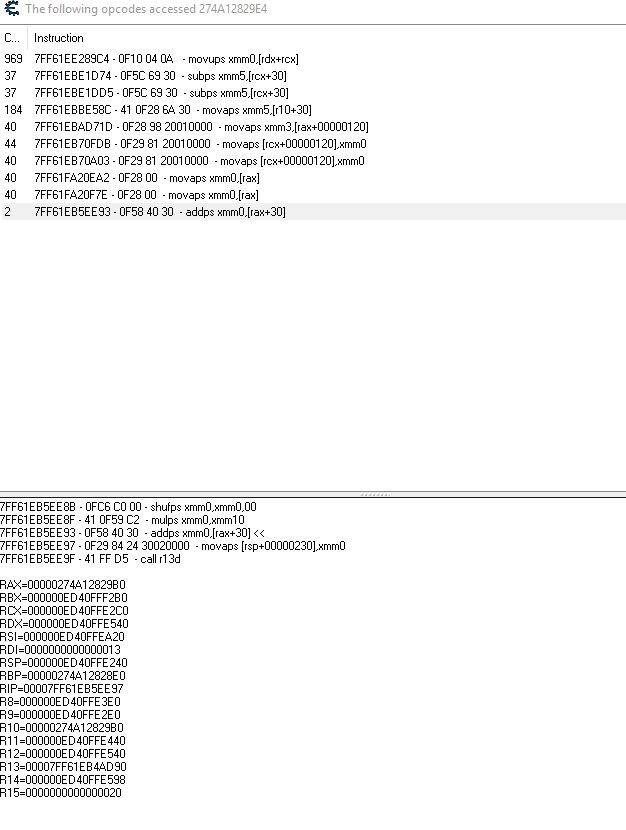| View previous topic :: View next topic |
| Author |
Message |
cascraft
Cheater
![]() Reputation: 0 Reputation: 0
Joined: 17 Jul 2015
Posts: 40
|
 Posted: Fri Dec 09, 2016 7:51 am Post subject: How to load and save values? Posted: Fri Dec 09, 2016 7:51 am Post subject: How to load and save values? |
 |
|
how can i load and save my values?
i have x, y, z player coords.
|
|
| Back to top |
|
 |
Corroder
Grandmaster Cheater Supreme
 Reputation: 75 Reputation: 75
Joined: 10 Apr 2015
Posts: 1668
|
|
| Back to top |
|
 |
cascraft
Cheater
![]() Reputation: 0 Reputation: 0
Joined: 17 Jul 2015
Posts: 40
|
 Posted: Fri Dec 09, 2016 12:46 pm Post subject: Posted: Fri Dec 09, 2016 12:46 pm Post subject: |
 |
|
first of all, thanks for that link but...
It looks diffrend. i dont have "eax+"
My

wich one should i take here?
|
|
| Back to top |
|
 |
++METHOS
I post too much
![]() Reputation: 92 Reputation: 92
Joined: 29 Oct 2010
Posts: 4197
|
 Posted: Fri Dec 09, 2016 2:32 pm Post subject: Posted: Fri Dec 09, 2016 2:32 pm Post subject: |
 |
|
| The target is x64, which is why you are seeing different registers. Use an instruction that is only accessing your coordinate value and nothing else, if possible...preferably, several times per second.
|
|
| Back to top |
|
 |
cascraft
Cheater
![]() Reputation: 0 Reputation: 0
Joined: 17 Jul 2015
Posts: 40
|
|
| Back to top |
|
 |
++METHOS
I post too much
![]() Reputation: 92 Reputation: 92
Joined: 29 Oct 2010
Posts: 4197
|
 Posted: Fri Dec 09, 2016 5:30 pm Post subject: Posted: Fri Dec 09, 2016 5:30 pm Post subject: |
 |
|
Right-click on your coordinate address inside of your cheat table and select 'find out what accesses...'. In the new debugger window that pops up, right-click on an empty, white space and select 'check if found opcodes...'.
If you see any results that are constantly being accessed and have a (1) next to them, then you're probably good to use that instruction for your hook.
|
|
| Back to top |
|
 |
cascraft
Cheater
![]() Reputation: 0 Reputation: 0
Joined: 17 Jul 2015
Posts: 40
|
|
| Back to top |
|
 |
++METHOS
I post too much
![]() Reputation: 92 Reputation: 92
Joined: 29 Oct 2010
Posts: 4197
|
 Posted: Fri Dec 09, 2016 6:23 pm Post subject: Posted: Fri Dec 09, 2016 6:23 pm Post subject: |
 |
|
Not interested in looking at the videos, sorry.
If there are no instructions that are exclusive to your coordinate address, then you'll need to filter out all of the non-relative addresses. Complete the last step of the CE tutorial that covers data structure dissection so that you can learn how to implement a unique ID for filtering out unwanted addresses (non-coordinate addresses).
Other methods used for finding a reliable ID for filtering purposes:
| ++METHOS wrote: | - You can use a pointer address for your filter, inside of your script, for the value that you are trying to manipulate.
- You can use pointer trees inside of the data structure to find something viable.
- You can shift the data structure (+ or -) and/or expand its size to find something useful.
- You can use the structure spider to find workable strings and/or for comparative analysis.
- You can check the register values by attaching the debugger or setting a breakpoint to see if something can be used for your filter.
- You can check to see if there are any instructions that are exclusive to the address/value that you are trying to manipulate and store the address for your filter by creating a second injection point.
- You can check to see if there are any instructions that are exclusive to any other address/value inside of the data structure for the address/value that you are trying to manipulate and store the address for your filter by creating a second injection point.
- You can analyze assembly code to see if an identifier is being checked or assigned somewhere.
- Et al.
|
|
|
| Back to top |
|
 |
|



